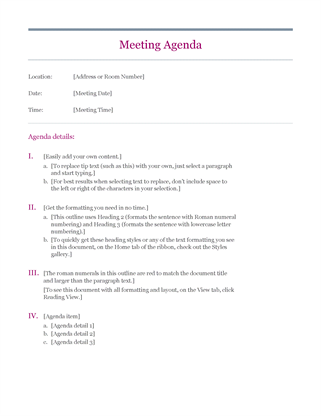
You make it a habit to conduct a meeting with your people at least once a week as an initiative for you to connect with them. Some meetings last for an hour, some even last up to three hours with heated arguments happening in the meeting session. In fact, most of the meetings did not give you a positive outcome. You begin to question your purpose of conducting meetings. Are you holding them to aid you in achieving your objectives? Or merely to inform your people about something in a more loud and clear manner and obtain their response? When you begin pondering about your decision to conduct meetings, you see clear signs that your decision leaned more towards the latter. Each meeting conducted incurred costs, turning into unnecessary expenses especially when your meetings do not meet your objectives or purpose. “Now what? Do I need to cut down my number of meetings? But I need to be on track with my people!” you think to yourself.

Meetings. A familiar event we usually be a part of in this busy business world. As a boss, what is your aim when you conduct a meeting? To me, it is all about making money. Your overall goal? To create value. Value, in the sense of a finalised conclusion that is worth more than the time cost utilised to conduct your meeting. It is not about blabbering in front of your people or just to inform them on important issues. Instead, you should be able to make a variable meeting conclusion that will aid your company in getting things done – the actions to take to get it done and the intended outcome.

Speaking of time costs, did you know that in America, 11 million times of meetings are held in total every single day? The time cost being spent on meetings ONLY comes up to a whopping sum of USD 37 billion! It is easy for them to hold meetings as they do not need any authority from the finance department. But that is A LOT! So, how are we going to cut the meeting time costs in our country? Therefore, before you simply decide on holding a meeting, make sure you are clear of the direction you are heading towards or you may end up wasting not only time, but money too. Conducting an effective workplace meeting should be your ultimate goal.
Perhaps you are unable to see the clear picture yet, which is why I am introducing you to Isaac. Isaac works in the financial investment industry and it requires him to attend many meetings with his clients and employees. Meetings are held online, but some also require him to talk with them on the phone for very long hours. Under certain circumstances, Isaac needs to commute to work and he ended up being stuck in the traffic jam when he was making his way to the meeting venue. Time, energy, and motivation were all adversely affected. As a result, Isaac felt extremely stressed and exhausted. This was also due to the fact that he had very little to no time at all to play golf with his friends, which was mainly caused by his busy job.
One day, Isaac’s friend called him out for a game of golf. Unfortunately, Isaac was too busy that he had to reject the offer. His friend, who is a CFO, noticed something felt off so he started questioning Isaac on his situation. Having Isaac explaining his entire dilemma on being too occupied with meetings, his CFO friend had the perfect solution for him.
What Exactly is a Meeting?

In a usual course of any business, we keep hearing the word ‘meeting’. But what exactly is a meeting? When you gather with your people, is that a meeting? When your people sit together in a group, is that a meeting? How about, when your people come to you to report their work progress, is that considered a meeting too? When your sales department people report the sales progress every morning to you, would that count as a meeting? Perhaps having the leader of a department coordinate a discussion within the organisation, would you consider it as a meeting? Or, maybe on a usual basis where you talk to your people one-on-one, does that fulfil the requirements of a ‘meeting’? There are so many different scenarios that involve you and your people meeting up, but to what extent could you consider them as a ‘meeting’?
So how can you consider one session as a meeting? A meeting is actually a business model. Being similar to other business activities, a meeting is supposed to have input and produce an economic gain. In a meeting, your input is a combination of the capabilities of your participants in making a decision and the time costs; and the output will be your final conclusion produced from the input. Through thorough discussions in a meeting, the knowledge of you and your participants shall at one point, be combined. By achieving an output through a two-in-one input that considers each party’s knowledge and opinions within a specific time frame, the definition of an effective meeting shall be met. This is a business model conclusion, and it needs to be worth more than your time costs.
Costs Needed to Conduct a Meeting

Like I mentioned above, the conclusion needs to be bigger than the time costs. This is obtained from everybody’s time cost multiplied by the total number of members who attended your meeting multiplied by the meeting time.
Time Cost = Employee’s time cost x Total no. of member who attended meeting x Meeting time
Based on the above formula, take it this way: the meeting time cost when a company’s employee time cost is RM100/hour and 20 people were needed to launch a 2-hour meeting is formulated by RM100 x 20 people x 2 hours = RM4,000. Let’s say the company here sells mobile phones earning a profit of RM40 per phone sold. Since the meeting costs RM4,000, the company needs to sell 100 phones to be able to hold the meeting. However, the company still cannot simply opt to conduct a meeting or else RM4,000 will be wasted for no reason at all. It makes it more difficult for a company to hold a meeting when the finance department needs to authorise the costs needed to conduct a meeting.
You know a meeting needs to bring value to your company, and it incurs costs that could end up being quite significant to your company’s expenses. So how do you maximise your meeting’s effectiveness so that you are not wasting resources, especially time and money? To make a meeting effective, you can structure it into three stages – before, during, and while closing your meeting.
Before your meeting
This is the longest process and most important to determine if your meeting will be effective or otherwise. In this stage, you work towards creating the conclusion value.
CONSENSUS

It is a necessity for you to achieve a consensus between you and your people. A staff meeting is where you are able to combine the mindset of all of your people. In a situation where few departments come together to voice out their department process, or when you discuss with your people about a price policy every morning, you do not consider these as meetings – they are just briefings instead. Unlike meetings, briefings do not need a consensus between you and your people.
By adding consensus into the conclusion value, you could determine if your meeting should be organised or not. If the level of consensus does not seem convincing, maybe the meeting should not be held after all, as a meeting is a high-cost interaction process. If this is the case, utilise a synchronised communication method beforehand, that is use emails, SMS, or instant messaging with your people to obtain feedback and gain consensus.
CONCLUSION VALUE

So you successfully gained consensus from your people, great! Now you can proceed to the second conclusion value, that is to establish a co-creation with your people. This is the process of doing research on the client’s plans together to solve your customers’ issues. A seminar could be done in this stage and you then have your department executive observe operations for a few days, also known as strategic planning. As for the technical department, co-creation is promoted by brainstorming ideas on what a planned product will be like.
AGENDA ATTENDEES

You have now created a clear conclusion value. It is time to step forward and hold a meeting. Remember to have an agenda and ensure your people required to attend the meeting have the necessary information needed to finalise decisions for 2/3 agenda items. Bear in mind the two-thirds rule, i.e. if 2/3 of relevant individuals are not there, do not hold the meeting.
During your meeting

You are finally holding a meeting and you are one step closer to achieving your intended outcome. Here, you can use five areas to ensure your meeting is as effective as possible:
1. “As if” / What would happen if?
You provide a context so that you can access information that may not be available due to some restrictions in the present state.
2. Practice a conditional close
You create scenarios or ask your people questions like “if I do X, will you do Y?”.
3. Alert your people if their mind appears to be wandering
You remind them that you will ask them to backtrack the whole discussion to ensure their minds remain on track.
4. Assign polarity person a job to do
Polarity people, who usually see things in the opposite manner, may cause demoralisation of other people in your company. But this is not a reason they should not be involved. Make use of their presence! Assign them a role such as the devil’s advocate to motivate others to perform better.
5. Dealing with conservatives
Conservatives are a tricky group of people to deal with, as they are only willing to do things the usual way. Therefore you may need to manipulate their minds a bit or offer them something in their interests, to make them do things differently.
Closing your meeting

Record the important notes as per discussion with your people. The ways needed to be taken to achieve your intended outcome can be easily represented by “WHO do WHAT by WHEN”. It gives you a clear view of who should get the job done before the specified time. With this, the meeting is effective when everyone has a clear understanding of their responsibilities and overall goal to achieve together.
You may be new to the whole practice of conducting meetings, hence you feel it is impossible for you to even reach a consensus before holding a meeting. I was once in your shoes too, and my advice is to do more meetings to create more value. I used to place too much emphasis on consensus, but still find a way to create value with my people. As a start, you could also limit the number of participants, perhaps to a maximum of eight persons; and to make the meeting duration shorter. This will help you ease communication.

However, if you are going for a one-way communication, then please avoid meetings because you will waste time and money. Opt for simpler communication methods instead, such as announcements, newsletters, or memos. If you are still going to hold a meeting but could not have all parties physically present, online conferencing would work well. A good platform that I suggest to you is LARK.
LARK is the next-generation collaboration suite that enables teams to do their best work together. The suite primarily consists of Lark Messenger, Lark Docs, Lark Calendar, Lark Video Conferencing, as well as Lark Workplace which integrates third-party applications. All functionalities are deeply integrated into a single app, which is available on Mac, PC, iOS, and Android.
Download Lark App for Free: https://www.larksuite.com
The CFO helped Isaac plan his meeting based on the three stages. As a result, Isaac conducted fewer meetings since his meetings became more effective, with value being created successfully. With more time to spend for himself and to play golf with his friends, Isaac is now much happier and stress-free. Meetings are finally the least of his worries.
